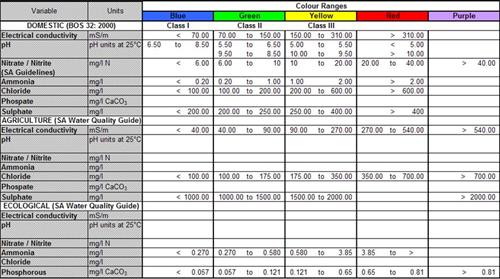South Africa’s Department of Water Affairs (DWA) has defined water quality based on its ‘fitness for use’. Indicator variables of concern have been chosen to monitor fitness for use of water, and guidelines developed depending on its intended use.
Water quality guidelines describe how changes in water quality will affect the user, rather than interpreting whether this is acceptable or not. Cut-off values for the different fitness for use categories are given in the Fitness for Use table below. The most sensitive water uses are domestic and irrigation, with industrial and mining uses being much more tolerant of lower water quality. Ecosystems are generally sensitive to poor water quality and if not in immediate peril, can be a valuable indicator of water quality and any existing pollution sources.
Water quality is monitored and compared against guidelines. It is important that a relevant set of water quality guidelines be compiled for each water use and for each variable of concern. These guidelines can be found in the Botswana Bureau of Standards for Drinking Water Specifications (BOBS 32:2000) and the South African Water Quality Guidelines, Volumes 1 to 7 (DWAF 1996a-g). Namibia’s water quality standards are the same as the WHO standards; those for Lesotho are less strict than the WHO standards (WHO 2000).
The tables below shows the acceptable ranges and cut-off values for the fitness for use categories per user and per variable. Blue indicates the ideal range, Green the acceptable range, Yellow is tolerable, Red is unacceptable and Purple is worse case scenario. For our purposes, only three of the five water-use categories are presented in the table below: domestic use, agricultural use (irrigation) and the aquatic ecology. Mining and industrial ranges are not included.
Fitness for Use

Look-up table for fitness- for-use of water.
Source:DWA South Africa 2009
( click to enlarge )
